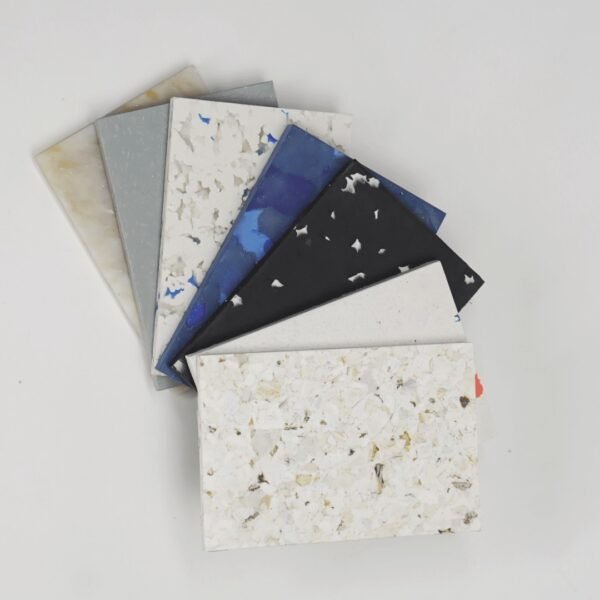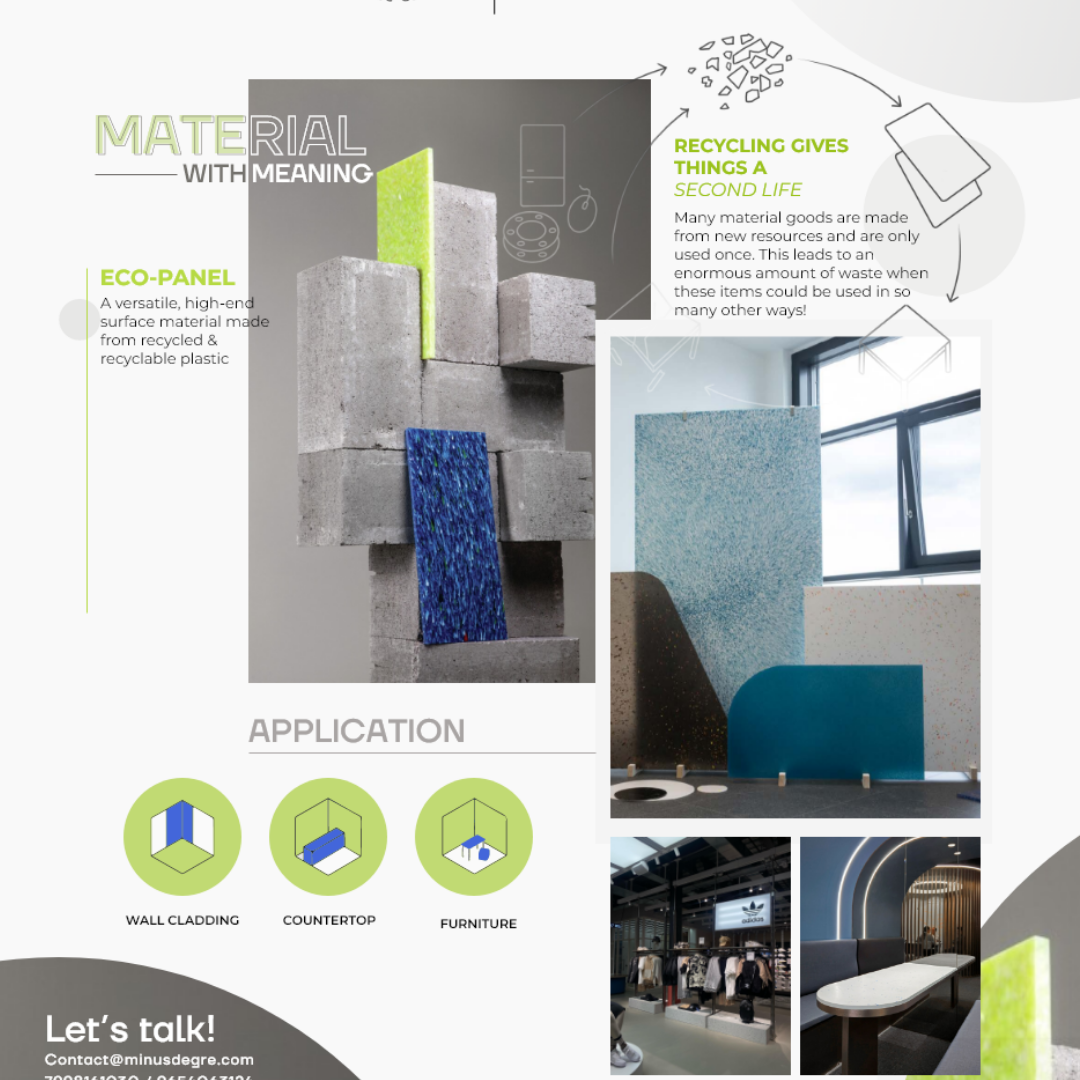In today’s rapidly evolving construction industry, green building materials are no longer a trend—they’re the future. As architects, builders, and designers shift toward eco-friendly construction materials, the demand for sustainable, durable, and aesthetically rich products is higher than ever.
At the forefront of this transformation is Minus Degre, an Indian innovator turning plastic waste into premium recycled plastic surfaces — including eco-panels, tiles, and wall panels that are redefining sustainable design.
This article explores Minus Degre’s impact and other top eco-friendly building materials shaping the next era of architecture.
What Are Green Building Materials?
Green building materials are designed to reduce environmental impact, conserve energy, and enhance indoor air quality. These materials are often:
-
Made from recycled or renewable sources
-
Energy-efficient in production and use
-
Non-toxic and low in VOC emissions
-
Locally sourced to reduce transportation emissions
Using sustainable materials not only minimizes waste but also helps projects qualify for certifications like LEED, IGBC, GRIHA, and BREEAM, showcasing a genuine commitment to green construction.
🌍 Minus Degre Eco-Panels: India’s Innovation in Recycled Plastic Surfaces
Leading the sustainability movement in India, Minus Degre’s Eco-Panel is a 100% recycled and recyclable surface material made from post-consumer and industrial plastic waste. Designed for retail, architecture, and interiors, these panels blend modern aesthetics with eco-conscious functionality.
Key Features of Minus Degre Eco-Panels
- Sourced from post-consumer and industrial plastic waste
- UV-stable, waterproof, and termite-resistant
- Can be machined, drilled, or cut like wood
- Available in textures mimicking marble, terrazzo, and concrete
- Used by brands like Adidas, Tata EV, and Aldo
From countertops and cabinets to decorative wall cladding, these panels have become the go-to solution for eco-conscious designers across India and abroad.

🧱 Eco-Tiles and Wall Panels by Minus Degre
In addition to solid surface panels, Minus Degre produces eco-tiles and wall panels — lightweight, colorful, and customizable.
Perfect for:
-
Feature walls in offices, cafés, or homes
-
Retail store displays and branded installations
-
Interior dividers and partitions
-
Corporate sustainability projects
Each tile is impact-resistant, easy to clean, and long-lasting, offering an eco-friendly alternative to ceramic or PVC tiles.
Applications in Real Spaces
Minus Degre’s products are already installed in flagship stores, sustainable showrooms, cafes, and public events, proving that design and environmental responsibility can coexist beautifully. Their work with designers from Bangalore to Melbourne showcases how recycled plastic panels can elevate spaces while aligning with brand values.



Other Top Eco-Friendly Building Materials Transforming Architecture
While recycled plastic panels are becoming an essential part of green interiors, the sustainable materials universe is vast and growing. Here are some of the most innovative and widely adopted materials in green construction:
1. Bamboo
An incredibly renewable and fast-growing plant, bamboo is used for:
- Flooring
- Wall cladding
- Furniture and partitions
It’s stronger than many hardwoods and grows 10x faster, making it a favorite among eco-conscious builders.

2. Recycled Steel
Instead of mining new ore, builders now opt for recycled steel, which:
- Reduces energy consumption by up to 75%
- Is extremely strong and durable
- Can be reused repeatedly without quality loss
Ideal for structural frameworks in green buildings.
3. Cork
Harvested from tree bark without cutting the tree, cork is:
- Naturally antimicrobial and insulating
- Used in flooring, wall panels, and acoustics
- Completely biodegradable
Cork’s unique texture also adds natural warmth to interior designs
.
4. Reclaimed Wood
Sourced from old buildings, ships, and furniture, reclaimed wood reduces deforestation and:
- Adds rustic character
- Is more stable due to aging
- Can be used for flooring, beams, and panels
It tells a story while saving trees.
5. Hempcrete
Made from hemp fibers, lime, and water, Hempcrete is:
- A strong, insulating bio-composite
- Carbon-negative during production
- Great for thermal insulation and non-load-bearing walls
Hemp grows quickly and doesn’t deplete the soil, making it a regenerative material.
6. Low-VOC Paints
Traditional paints release volatile organic compounds (VOCs) harmful to human health. Eco-friendly, low-VOC or no-VOC paints improve indoor air quality and are:
- Safer for occupants
- Widely available
- Used in green certified buildings
7. Mycelium
A futuristic material grown from mushroom roots, Mycelium can be molded into:
- Packaging
- Insulation panels
- Furniture and interior partitions
It’s biodegradable, fire-resistant, and incredibly lightweight.
Why Green Materials Are the Future of Construction
The construction sector contributes nearly 39% of global CO₂ emissions. Every material decision impacts the planet — from energy efficiency to indoor health.
By adopting Minus Degre’s Eco-Panels and other sustainable building materials, architects can design spaces that are:
-
Beautiful and functional
-
Low-impact and circular
-
Aligned with ESG and net-zero goals
By integrating solutions like Minus Degre Eco-Panels and other sustainable options, architects can create beautiful, durable, and responsible buildings that lead the way to a better future.

Minus Degre: A New Era for Sustainable Design
In a market flooded with greenwashing, Minus Degre stands out with real impact and transparency. With a mission to divert plastic from landfills and oceans, the brand continues to push boundaries by creating products that are:
- 100% recycled and recyclable
- Designed for real-world use
- Engineered for high design performance
From sustainable awards and recycled trophies to eco-conscious retail interiors, Minus Degre has become India’s go-to sustainable surface brand.

🌏 Build Green with Minus Degre
Join the growing movement of architects, builders, and businesses choosing Minus Degre’s recycled materials to transform construction sustainably.
👉 Visit Minus Degre’s website or contact us today to start building your next eco-conscious project.
________________________________________________________________________________________________________________
FAQ
1. What are green building materials, and why are they important?
Green building materials are eco-friendly alternatives used in construction that have minimal environmental impact. They are often made from renewable, recycled, or sustainable resources. These materials help reduce carbon emissions, improve energy efficiency, and promote healthier indoor environments. Using them supports sustainable architecture and helps fight climate change.
2. What is an Eco-Panel, and how is it made?
An Eco-Panel is a sustainable surface material made from 100% recycled plastic waste. At Minus Degre, these panels are crafted using post-consumer and industrial plastic, which is cleaned, shredded, and compressed into solid sheets. The result is a durable, water-resistant, and recyclable panel ideal for use in furniture, wall cladding, signage, and interior design applications.
3. Are Eco-Panels as durable as traditional materials like wood or MDF?
Yes. Minus Degre Eco-Panels are engineered to be extremely durable and long-lasting. They are:
-
Waterproof
-
Termite-resistant
-
UV-stable
-
Non-toxic and VOC-free
They can be cut, drilled, or joined using standard carpentry tools, making them a strong and sustainable alternative to MDF, plywood, or acrylic.
4. Where can Eco-Panels be used in construction or interior design?
Eco-Panels are highly versatile and can be used in:
-
Wall cladding and partitions
-
Retail store fixtures and displays
-
Modular furniture
-
Kitchen counters and shelves
-
Corporate branding and signage
-
Hospitality, educational, and office interiors
Their custom textures and finishes make them suitable for both aesthetic and functional purposes.
5. How does using Eco-Panels contribute to green building certifications?
Eco-Panels help earn points toward LEED, IGBC, and GRIHA certifications by contributing to waste reduction, use of recycled content, and indoor environmental quality. Since they are made from 100% post-consumer plastic and are fully recyclable, they support circular economy principles and demonstrate your project’s commitment to sustainability and ESG goals.








